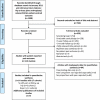What proportion of patients report long-term pain after total hip or knee replacement for osteoarthritis? A systematic review of prospective studies in unselected patients
- PMID: 22357571
- PMCID: PMC3289991
- DOI: 10.1136/bmjopen-2011-000435
What proportion of patients report long-term pain after total hip or knee replacement for osteoarthritis? A systematic review of prospective studies in unselected patients
Abstract
Background: Total hip or knee replacement is highly successful when judged by prosthesis-related outcomes. However, some people experience long-term pain.
Objectives: To review published studies in representative populations with total hip or knee replacement for the treatment of osteoarthritis reporting proportions of people by pain intensity.
Data sources: MEDLINE and EMBASE databases searched to January 2011 with no language restrictions. Citations of key articles in ISI Web of Science and reference lists were checked.
Study eligibility criteria, participants and interventions: Prospective studies of consecutive, unselected osteoarthritis patients representative of the primary total hip or knee replacement population, with intensities of patient-centred pain measured after 3 months to 5-year follow-up.
Study appraisal and synthesis methods: Two authors screened titles and abstracts. Data extracted by one author were checked independently against original articles by a second. For each study, the authors summarised the proportions of people with different severities of pain in the operated joint.
Results: Searches identified 1308 articles of which 115 reported patient-centred pain outcomes. Fourteen articles describing 17 cohorts (6 with hip and 11 with knee replacement) presented appropriate data on pain intensity. The proportion of people with an unfavourable long-term pain outcome in studies ranged from about 7% to 23% after hip and 10% to 34% after knee replacement. In the best quality studies, an unfavourable pain outcome was reported in 9% or more of patients after hip and about 20% of patients after knee replacement.
Limitations: Other studies reported mean values of pain outcomes. These and routine clinical studies are potential sources of relevant data.
Conclusions and implications of key findings: After hip and knee replacement, a significant proportion of people have painful joints. There is an urgent need to improve general awareness of this possibility and to address determinants of good and bad outcomes.
Conflict of interest statement
Figures


Comment in
-
Letter to the editor: Complications of total knee arthroplasty: standardized list and definitions of The Knee Society.Clin Orthop Relat Res. 2013 Nov;471(11):3706-7. doi: 10.1007/s11999-013-3236-8. Epub 2013 Sep 10. Clin Orthop Relat Res. 2013. PMID: 24018799 Free PMC article. No abstract available.
References
-
- National Joint Registry for England and Wales 7th Annual Report. Hemel Hempstead: NJR Centre, 2010
-
- DeFrances CJ, Lucas CA, Buie VC, et al. 2006 National Hospital Discharge Survey. National health statistics reports; no 5. Hyattsville MD: National Center for Health Statistics, 2008 - PubMed
-
- Kurtz S, Ong K, Lau E, et al. Projections of primary and revision hip and knee arthroplasty in the United States from 2005 to 2030. J Bone Joint Surg Am 2007;89:780–5 - PubMed
-
- Ranawat CS, Atkinson RE, Salvati EA, et al. Conventional total hip arthroplasty for degenerative joint disease in patients between the ages of forty and sixty years. J Bone Joint Surg Am 1984;66:745–52 - PubMed
-
- Aamodt A, Nordsletten L, Havelin LI, et al. Documentation of hip prostheses used in Norway: a critical review of the literature from 1996-2000. Acta Orthop Scand 2004;75:663–76 - PubMed
Grants and funding
LinkOut - more resources
Full Text Sources
Other Literature Sources
Medical
Research Materials
